2018-04-05 - Nº 153
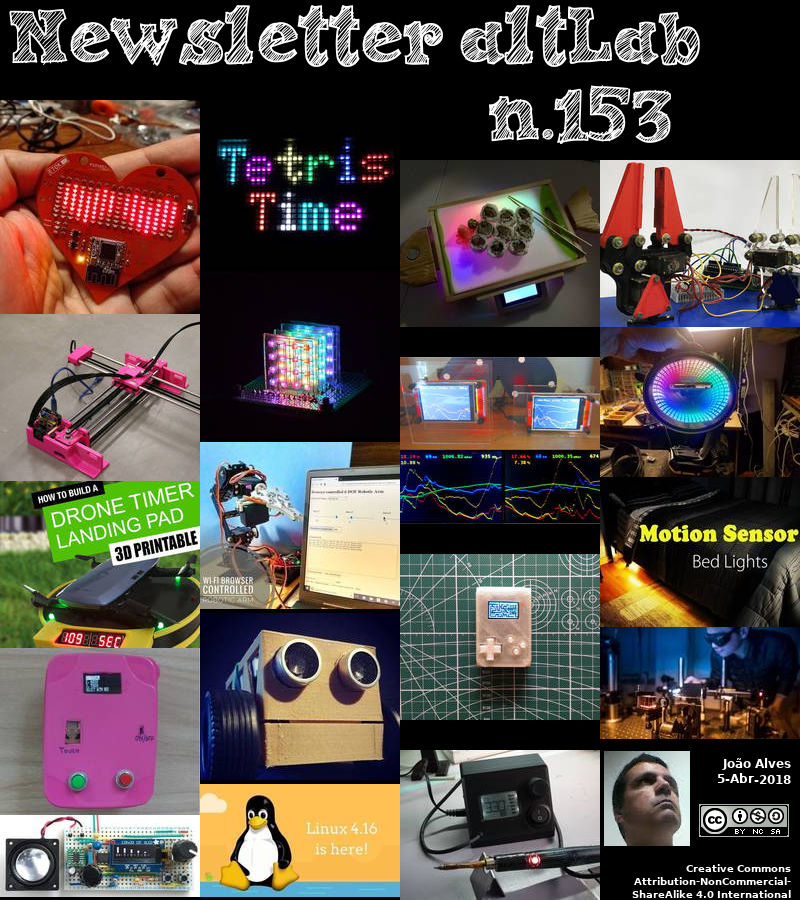
Editorial
Esta é a Newsletter Nº 153 que se apresenta com o mesmo formato que as anteriores. Se gostar da Newsletter partilhe-a!
Todas as Newsletters encontram-se indexadas no link.
Esta Newsletter tem os seguintes tópicos:
Faz anos hoje que nascia, em 1622, Vincenzo Viviani. Este matemático italiano foi líder em seu campo e fundou a Accademia del Cimento. Como uma das primeiras sociedades científicas importantes, esta organização foi criada antes da Royal Society da Inglaterra. Em 1639, aos 17 anos, tornou-se aluno, secretário e assistente de Galileu em Arcetri, até a morte de Galileu, em 1642. Durante sua longa carreira, Viviani publicou vários livros sobre assuntos matemáticos e científicos. Ele editou a primeira edição das obras unificadas de Galileu (1655-1656) e trabalhou incansavelmente para reabilitar a memória do seu mestre. Em 1660, junto com Borelli, ele mediu a velocidade do som ao sincronizar a diferença entre o flash e o som de um canhão. Eles obtiveram o valor de 350 metros por segundo. Ficou igualmente conhecido pelo teorema de Viviani, que estabelece que a soma das distancias de um ponto interior aos lados, num ângulo recto, de um triângulo equilátero é igual ao comprimento da altura do triângulo.
Faz também anos hoje que nascia, em 1827, Joseph Lister. Este cirurgião inglês e cientista médico foi o fundador da medicina anti-séptica e um pioneiro na medicina preventiva. Influenciado pela teoria dos germes de Louis Pasteur, Lister resolveu manter esses organismos longe das feridas. O seu livro, sobre o Princípio Anti-séptico na Prática da Cirurgia (1867), foi o primeiro tratado sobre o assunto. Enquanto na Royal Infirmary, Glasgow, Escócia, ele introduziu o uso do fenol como um desinfectante usado em ligaduras, utensílios, bem como para uso directo em feridas e lavagem das mãos do cirurgião. A sua primeira cirurgia foi realizada em 12 de Agosto de 1865. A prática médica moderna continua a seguir o princípio de Lister de que as feridas devem ser mantidas livres de bactérias, embora a esterilização tenha substituído o uso mais anticéptico.
Faz igualmente anos hoje que nascia, em 1892, Hermann Kemper. Este engenheiro alemão foi um pioneiro na levitação magnética. Kemper começou a sua pesquisa sobre levitação magnética em 1922. Em 1933, construiu um circuito funcional para pairar sobre o princípio da levitação electromagnética, usando a atracão electromagnética. Ele recebeu o número de Patente do Reich 643316, "Schwebebahn mit räderlosen Fahrzeugen, die an eisernen fahrschienen mittels magnetischer Felder schwebend entlang geführt wird" (a invenção de um hovertrack com veículos sem chumbo que pairam ao longo de trilhos de ferro usando campos magnéticos). Esta invenção acabou por levar ao desenvolvimento do Transrapid.
Faz também anos hoje que nascia, em 1894, Lawrence Dale Bell. Este fabricante e projectista de aviões americanos, fundador da Bell Aircraft Co., cujo avião experimental X-1, lançado em 1947, foi o primeiro a quebrar a barreira do som. Esta empresa também produziu contribuições significativas para a aviação, como o primeiro avião a jacto do país, o primeiro helicóptero comercial do mundo, o avião voador mais rápido e mais alto do mundo, o Bell X-1A, e o primeiro jato vertical de descolagem e pouso.
Por fim, faz anos hoje que nascia, em 1918, Joseph Sobek. Este inventor americano ficou conhecido pela invenção do Raquetebol que desenvolveu o desporto (1950) para jogar no Greenwich, Connecticut, YMCA. Como um profissional de squash e tênis por sete anos, ele inventou o Raquetebol como um desporto de raquetes indoor alternativo. Ele elaborou regras, desenhou um projecto de raquete, que foi criado em 1951 pela Magnan Racket Manufacturing Company. Para promover a sua invenção, ele fundou a Paddle Rackets Association com um grupo de jogadores. Ele se retirou da promoção activa quando o desporto rapidamente ganhou popularidade, como uma actividade desportiva que era fácil de aprender e que não precisava de força para desfrutar.
Esta semana que passou Linus Torvalds lançou o Linux 4.16. Esta versão foi um lançamento de peso com melhorias e correcções para várias arquitecturas, drivers, etc. Muito trabalho foi feito para aumentar a segurança com a ajuda de correcções de Specter e Meltdown e limpezas de código. No campo do suporte de CPUs, varias melhorias foram feitas para oferecer suporte a recursos mais recentes. Houve actualizações do RISC-V, suporte do KVM para o AMD Secure Encrypted Virtualization, assim como o driver Oracle DAX, etc. Foi desenvolvido trabalho também para melhorar o suporte para gráficos Cannonlake Gen 10, no Jetson TX2 e melhorias no AMDKFD.
Ficámos também a saber que a NASA contratou a Lockeed-Martin para desenvolver um novo avião supersónico. O contrato prevê o desenho, a construção e os testes do chamado "Low-Boom Flight Demonstrator". Este avião deverá ter a capacidade de transportar passageiros e deverá ter um ruído supersónico que permita ser aceite com os regulamentos em vigor. A aeronave será construída nas instalações da Lockheed Martin Skunk Works em Palmdale, Califórnia, e deverá fazer o seu primeiro voo em 2021.
Na Newsletter desta semana apresentamos diversos projetos de maker. É apresentado o livro CircuitPython Essentials, assim como a revista newelectronics de 27 de Março.
 João Alves ([email protected])
João Alves ([email protected])
O conteúdo da Newsletter encontra-se sob a licença  Creative Commons Attribution-NonCommercial-ShareAlike 4.0 International License.
Creative Commons Attribution-NonCommercial-ShareAlike 4.0 International License.
Novidades da Semana

Linus Torvalds Releases Linux Kernel 4.16
"I guess Linus Torvalds doesn’t like to make tons of jokes. That’s why after shipping seven release candidates for Linux kernel 4.16, he decided to released the final kernel on April Fools’ Day. He might have shipped RC8 just for the heck of it, with no changes, but that’s not his style. At the time of RC7 release, he called it a bigger release than usual. About half of the code update was networking. The final release looks a lot like RC7." [...]
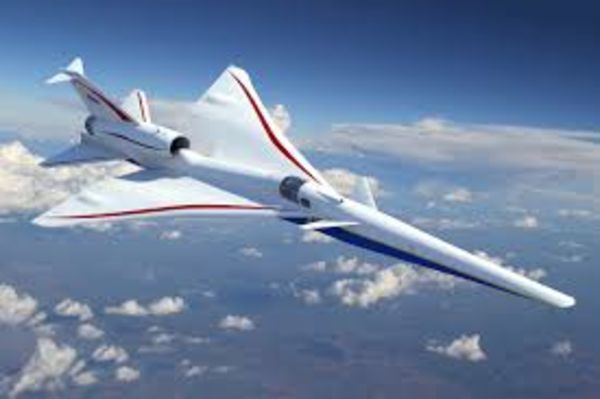
NASA Selects Lockheed Martin Skunk Works to Build X-Plane
"Supersonic commercial travel is on the horizon. Today NASA awarded Lockheed Martin (NYSE: LMT) Skunk Works® a contract to design, build and flight test the Low-Boom Flight Demonstrator, an X-plane designed to make supersonic passenger air travel a reality. "It is super exciting to be back designing and flying X-planes at this scale," said Jaiwon Shin, NASA's associate administrator for aeronautics. "Our long tradition of solving the technical barriers of supersonic flight to benefit everyone continues." Lockheed Martin Skunk Works will build a full-scale experimental aircraft, known as an X-plane, of its preliminary design developed under NASA's Quiet Supersonic Technology (QueSST) effort. The X-plane will help NASA establish an acceptable commercial supersonic noise standard to overturn current regulations banning commercial supersonic travel over land." [...]
Outras Notícias

SpaceX successfully launches Iridium-5 Falcon 9 mission
"SpaceX has successfully launched its Iridium -5 mission, which carries 10 satellites to add to Iridium’s NEXT global communications constellation. This is the fifth set of 10, out of a total of 75 that SpaceX is launching for client Iridium, and today’s launch used a first stage Falcon 9 booster originally employed last October for the third Iridium NEXT satellite launch. The launch included reuse of a flight proven rocket, but it did not include a recovery attempt for the first stage booster this time around. SpaceX attempted to recover one half of the fairing used during the launch, which is the protective metal shielding that covers the cargo as the rocket blasts through the atmosphere en route to space. The fairing alone is worth around $6 million, and SpaceX CEO Elon Musk has indicated that it would be relatively easy to refurbish this part for repeat flight, provided their recovery plan works. SpaceX was once again unsuccessful in recovering the fairing, per Musk." [...]

U.S. regulator approves SpaceX plan for broadband satellite services
" The top U.S. telecommunications regulator on Thursday gave formal approval to a plan by Elon Musk’s SpaceX to build a global broadband network using satellites. “This is the first approval of a U.S.-licensed satellite constellation to provide broadband services using a new generation of low-Earth orbit satellite technologies,” the Federal Communications Commission said in a statement. The system proposed by privately held SpaceX, as Space Exploration Holdings is known, will use 4,425 satellites, the FCC said. FCC Chairman Ajit Pai in February had endorsed the SpaceX effort, saying: “Satellite technology can help reach Americans who live in rural or hard-to-serve places where fiber optic cables and cell towers do not reach.” The Federal Aviation Administration said on Wednesday that SpaceX plans to launch a Falcon 9 rocket on April 2 at Cape Canaveral, Florida. “The rocket will carry a communications satellite,” the FAA said. The FCC said SpaceX has been granted authority to use frequencies in the Ka (20/30 GHz) and Ku (11/14 GHz) bands." [...]

Intel Core i9 Processor Comes to Mobile: The Best Gaming and Creation Laptop Processor Intel Has Ever Built
"Today at a global event in Beijing, Intel unveiled the first ever Intel® Core™ i9 processor for laptops. Part of the new lineup of high-performance mobile products unveiled, the powerful 8th Gen Intel Core i9 processor is the highest-performance laptop processor Intel has ever built to deliver the best gaming and content creation experience on the go. Building on the arrival of the new Intel Core i9 processor for mobile, Intel also announced a new Intel Core platform extension that brings together the benefits of 8th Gen Intel Core processors with Intel® Optane™ memory, rounded out its family of high-performance desktop CPUs and chipsets that deliver modern standby and ambient computing capabilities, and shared new details on the 8th Gen Intel® Core™ vPro™ platform. Delivering the ultimate gaming and content creation experience The new 8th Gen Intel Core i9, i7 and i5 processors for laptops are based on the Coffee Lake platform and leverage the 14nm++ process technology enabling them to deliver up to 41 percent more frames per second in gameplay1 or edit 4K video up to 59 percent faster than the previous generation with same discrete graphics.2 At the top of the stack, the 8th Gen Intel Core i9-8950HK processor is optimized to push the limits of performance. It is the first mobile Intel processor with six cores and 12 threads. It comes fully unlocked and features the new Intel Thermal Velocity Boost (TVB), which opportunistically and automatically increases clock frequency up to 200 MHz if the processor temperature is low enough and turbo power budget is available." [...]

Innovative Low-Dropout Voltage Regulator from STMicroelectronics Packs Big Performance in Tiny Footprint
"STMicroelectronics’ STLQ020 low-dropout (LDO) voltage regulator relieves the familiar trade-offs between quiescent current, output power, dynamic response, and package size, to give designers extra freedom. By combining small size with high performance and energy efficiency, the STLQ020 is ideal for use in battery-powered consumer products like smartphones and tablets, smart watches, audio or media devices, and wearables. It helps extend battery life in IoT endpoints such as smart meters and wireless sensors, healthcare devices like wearable monitors, and industrial applications such as factory automation or sensor networking. Drawing just 300nA quiescent current (Iq), and capable of supplying up to 200mA to the load with excellent regulation, power-supply rejection (PSRR), and transient response, the STLQ020 is available in a choice of compact packages reaching as small as a 0.8mm x 0.8mm flip-chip4. This unique combination of attributes stems from the STLQ020’s dedicated low-power design and adaptive bias circuitry, which ensures fast response and a stable output with high PSRR. In addition, dropout voltage as low as 160mV (typical) at maximum load allows longer equipment runtimes as the battery discharges." [...]

Maxim's Low-Power Microcontrollers Extend Battery Life for Wearables and Other Compact Devices
"MAX32660 and MAX32652, based on the low-power Arm Cortex-M4, are ideal for wearable sensors and battery-powered applications Designers of internet of things (IoT) sensors, environmental sensors, smartwatches, medical/preventive health wearables, and other size-constrained devices can now increase battery life and functionality using the ultra-low power MAX32660 and MAX32652 microcontrollers from Maxim Integrated Products, Inc. (NASDAQ: MXIM). These microcontrollers (MCUs) are based on the Arm® Cortex®-M4 with FPU processor and provide designers the means to develop advanced applications under restrictive power constraints. Maxim's family of DARWIN MCUs combine our wearable-grade power technology with the biggest embedded memories in their class and some of the most advanced embedded security in the world. MAX32660: Powerful processing in the tiniest form factor Memory, size, power consumption, and processing power are critical features for engineers designing more complex algorithms for smarter IoT applications. Existing solutions today offer two extremes—they either have decent power consumption but limited processing and memory capabilities, or they have higher power consumption with more powerful processors and more memory. The MAX32660 offers designers a sweet spot, giving them access to enough memory to run some advanced algorithms and manage sensors (256KB flash and 96KB SRAM)." [...]
Ciência e Tecnologia
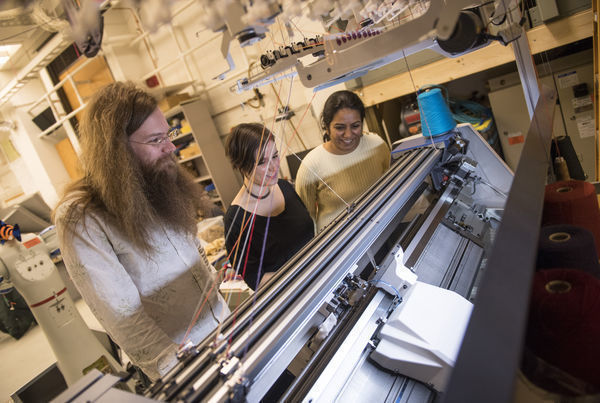
Software Automatically Generates Knitting Instructions for 3-D Shapes
"CMU Researchers Foresee Machines Capable of On-Demand Knitting Carnegie Mellon University computer scientists have developed a system that can translate a wide variety of 3-D shapes into stitch-by-stitch instructions that enable a computer-controlled knitting machine to automatically produce those shapes. Researchers in the Carnegie Mellon Textiles Lab have used the system to produce a variety of plush toys and garments. What's more, this ability to generate knitting instructions without need of human expertise could make on-demand machine knitting possible, according to James McCann, assistant professor in the Robotics Institute and leader of the lab. McCann's vision is to use the same machines that routinely crank out thousands of knitted hats, gloves and other apparel to produce customized pieces one at a time or in small quantities. Gloves, for instance, might be designed to precisely fit a customer's hands. Athletic shoe uppers, sweaters and hats might have unique color patterns or ornamentation." [...]

Future electric cars could recharge wirelessly while you drive
"Electric vehicles may one day be able to recharge while driving down the highway, drawing wireless power directly from plates installed in the road that would make it possible to drive hundreds—if not thousands—of miles without having to plug in. While the idea may sound like science fiction, CU Boulder engineers are working to bring it closer to reality. “We’d like to enable electric vehicles to charge on the go,” said Khurram Afridi, an assistant professor in CU Boulder’s Department of Electrical, Computer and Energy Engineering. Over the last two years, Afridi and his colleagues have developed a proof of concept for wireless power transfer that transfers electrical energy through electric fields at very high frequencies. The ability to send large amounts of energy across greater physical distance to in-motion platforms from low cost charging plates could one day allow the technology to expand beyond small consumer electronics like cell phones and begin powering bigger things like automobiles. Currently, most electric vehicles can travel between 100 and 250 miles on a single charge, depending on the make and model." [...]
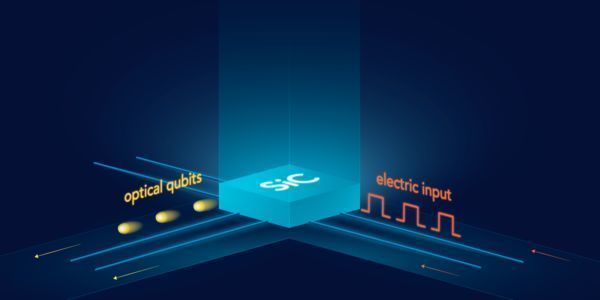
Physicists reveal material for high-speed quantum internet
"Researchers from the Moscow Institute of Physics and Technology have “rediscovered” a material that can lay the foundation for ultrahigh-speed quantum internet. Their paper published in npj Quantum Information shows how to increase the data transfer rate in unconditionally secure quantum communication lines to more than 1 gigabit per second, making quantum internet as fast as its classical counterpart. The race for quantum computing is on: Industry giants, such as Google, IBM, and Microsoft, and leading international research centers and universities are involved in the global effort to build a quantum computer. It is not known yet when this new technology can become a reality, but the world is getting ready. The greatest expectation about the quantum computer is that it could break the security of all classical data transfer networks. Today, sensitive data such as personal communication or financial information are protected using encryption algorithms that would take a classical supercomputer years to crack." [...]

Engineers turn plastic insulator into heat conductor
"Technique could prevent overheating of laptops, mobile phones, and other electronics. Plastics are excellent insulators, meaning they can efficiently trap heat — a quality that can be an advantage in something like a coffee cup sleeve. But this insulating property is less desirable in products such as plastic casings for laptops and mobile phones, which can overheat, in part because the coverings trap the heat that the devices produce. Now a team of engineers at MIT has developed a polymer thermal conductor — a plastic material that, however counterintuitively, works as a heat conductor, dissipating heat rather than insulating it. The new polymers, which are lightweight and flexible, can conduct 10 times as much heat as most commercially used polymers. “Traditional polymers are both electrically and thermally insulating." [...]
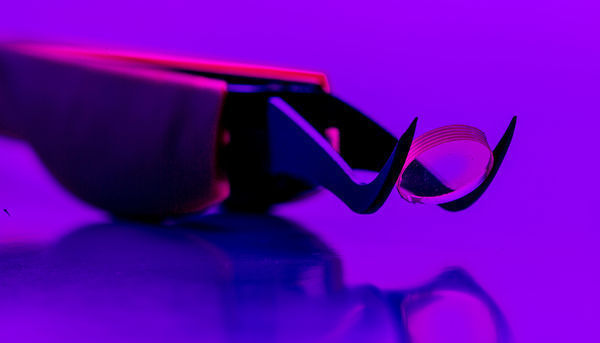
Lab scientists successfully print glass optics
"For the first time, researchers at Lawrence Livermore National Laboratory (LLNL) have successfully 3D-printed optical-quality glasses, on par with commercial glass products currently available on the market. In a study published in the journal Advanced Materials Technologies (link is external), LLNL scientists and engineers describe successfully printing small test pieces from Lab-developed ink with properties “within range of commercial optical grade glasses.” Because the refractive index of glass is sensitive to its thermal history, it can be difficult to ensure that glass printed from the molten phase will result in the desired optical performance, researchers said. Depositing the LLNL-developed material in paste form and then heating the entire print to form the glass allows for a uniform refractive index, eliminating optical distortion that would degrade the optic's function. "Components printed from molten glass often show texture from the 3D-printing process, and even if you were to polish the surface, you would still see evidence of the printing process within the bulk material,” said LLNL chemical engineer Rebecca Dylla-Spears, the project’s principal investigator. “This approach allows us to obtain the index homogeneity that is needed for optics. Now we can take these components and do something interesting.” The custom inks, aimed at forming silica and silica-titania glasses, allow researchers the ability to tune the glass’s optical, thermal and mechanical properties, Dylla-Spears said." [...]
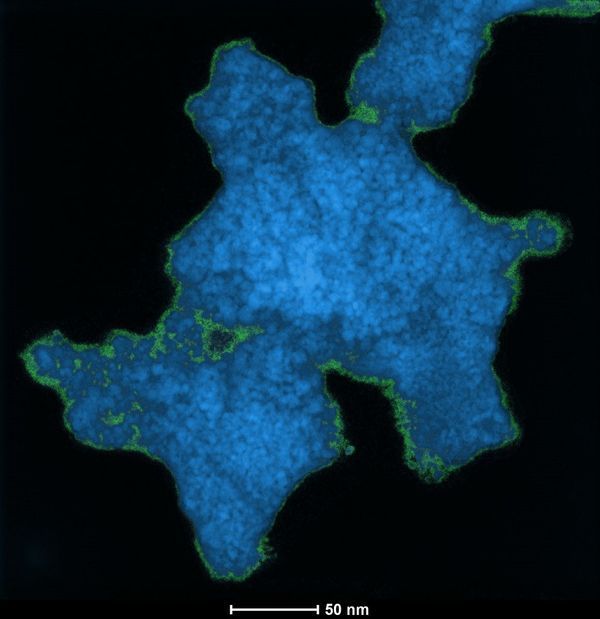
What a mesh
"A team of scientists from across the U.S. has found a new way to create molecular interconnections that can give a certain class of materials exciting new properties, including improving their ability to catalyze chemical reactions or harvest energy from light. In a new study, researchers at the U.S. Department of Energy’s (DOE) Argonne National Laboratory, the University of California-Los Angeles, the University of California-Santa Barbara, Purdue University and the University of Oregon have developed a method to create linked networks of metal oxides that could have interesting catalytic or electronic properties. “If we can stitch in these molecules exactly where we want them to be, it will give us a powerful ability to make and understand hybrid materials with a wide range of uses.” — UCLA chemist Alexander Spokoyny Metal oxides are of interest to scientists because of their unique electronic and chemical properties. Some, like titanium dioxide, are commonly used in photovoltaic and photocatalytic applications because of their ability to absorb light. The key to forming these metal oxide networks is boron, which when annealed with metal oxides leads to the formation of thermally robust and stable interconnected clusters that act as strands of glue that connect a metal oxide web. “This glue has the ability to be a key component of the entire reactive system, changing the properties that the metal oxides had on their own,” said Alexander Spokoyny, a chemist at UCLA." [...]
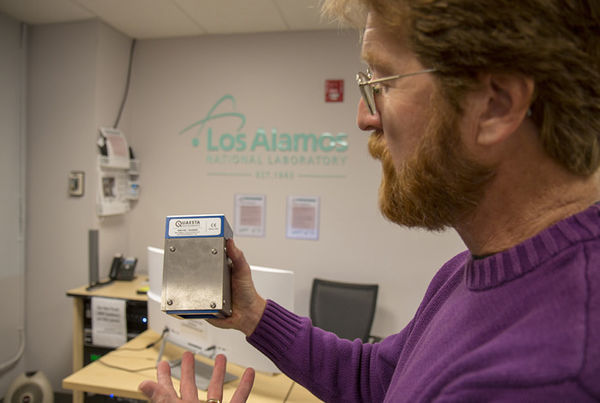
Innovative detectors quickly pinpoint radiation source
"‘Lighthouse’ detectors minimize workers’ exposure to dangerous radiation Innovative “lighthouse” detectors that use a sweeping beam to quickly pinpoint a radiation source in seconds are reducing radiation exposure for workers and opening up new areas for robotic monitoring to avoid potential hazards. “It’s easier to find a needle in a haystack if the haystack is small,” said Jonathan Dowell, a Los Alamos scientist and inventor of the detector. He was referring to the detectors’ ability to hone in on an area while eliminating background noise or naturally occurring radiation. On the detectors, directional sensors similar to a beam atop a lighthouse scan through a narrow angle looking for radiation. The Laboratory uses the detectors aboard HAZMAT robots for emergency response, as well as to conduct geologic surveys. “The more we can reduce radiation exposure, the better it is for the people doing the work,” said Dowell." [...]

Kesterite solar cells: germanium promises better opto-electronic properties than tin
"Specific changes in the composition of kesterite-type semiconductors make it possible to improve their suitability as absorber layers in solar cells. As a team at the Helmholtz-Zentrum Berlin showed, this is particularly true for kesterites in which tin was replaced by germanium. The scientists examined the samples using neutron diffraction at BER II and other methods. The work was selected for the cover of the journal CrystEngComm. Kesterites are semiconductor compounds made of the elements copper, tin, zinc, and selenium. These semiconductors can be used as an optical absorber material in solar cells, but so far have only achieved a maximum efficiency of 12.6 per cent, while solar cells made of copper-indium-gallium-selenide (CIGS) already attain efficiencies of over 20 percent." [...]
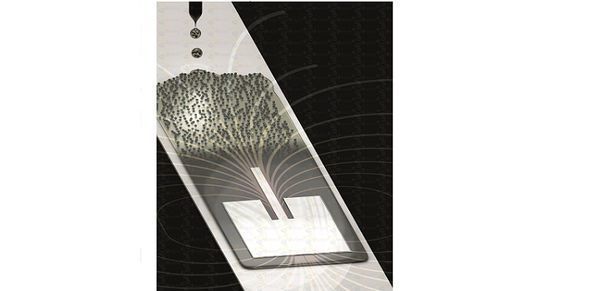
Tuning in to magnetic ink
"A new ink containing iron-oxide nanoparticles can be turned into fully printed and versatile components for cellular networks. Inkjet printing technology can be used to produce radio frequency devices, such as antennas, that can be magnetically reconfigured on demand. This discovery by a team from KAUST boosts prospects for inexpensive electronics that work worldwide by tuning in to multiple cellular bands and standards. A typical cellphone antenna is made by depositing metallic patterns onto insulating silicon or glass wafers. These miniature aerials have excellent reliability, but only operate at fixed frequency bands. To fabricate devices that can adapt to different wireless settings, researchers are increasingly turning to magnets." [...]
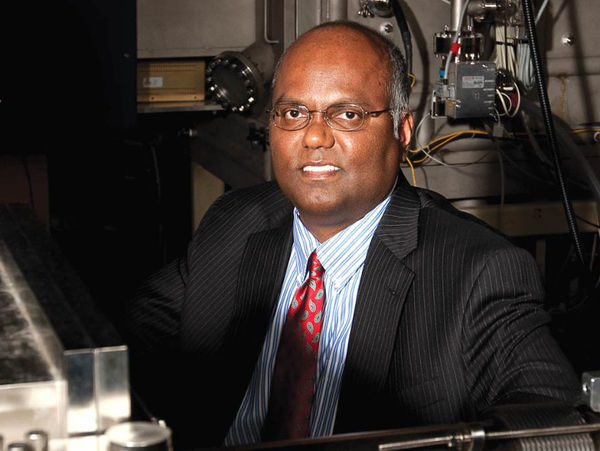
Researchers Seek to Improve Quality Control for Nanomanufacturing
"New Monitoring Tool Would Be Able to Detect Imperfections Almost Instantaneously Researchers from the University of Houston are developing a new quality control tool for continuous nanomanufacturing, a key step in moving nanodevices from the lab to the real world. “Nanomanufacturing sounds great, but it really has to be scalable,” said Venkat Selvamanickam, MD Anderson Chair Professor of Mechanical Engineering. “You have to be able to control the quality.” Selvamanickam is working with Nanomanufacturing Systems for mobile Computing and Energy Technologies (NASCENT), a multi-institution partnership led by the University of Texas at Austin, to develop the new tool, which will adapt Raman Spectroscopy and X-ray Diffraction for use with roll-to-roll continuous manufacturing processes. The work will be done under the auspices of the UH Advanced Manufacturing Institute; UH will receive about $340,000 from the National Science Foundation for the project. One of the world’s leading experts on manufacturing superconductors, Selvamanickam oversees manufacturing activity at the University’s Energy Research Park, including the advanced manufacturing of high-performance superconductor wires for next-generation electric machines. He is also director of the Applied Research Hub at the Texas Center for Superconductivity at UH and manages the Advanced Manufacturing Institute, an umbrella organization designed to help researchers make the leap between discovery and commercialization." [...]

Berkeley Lab Scientists Print All-Liquid 3-D Structures
"Scientists from the Department of Energy’s Lawrence Berkeley National Laboratory (Berkeley Lab) have developed a way to print 3-D structures composed entirely of liquids. Using a modified 3-D printer, they injected threads of water into silicone oil — sculpting tubes made of one liquid within another liquid. They envision their all-liquid material could be used to construct liquid electronics that power flexible, stretchable devices. The scientists also foresee chemically tuning the tubes and flowing molecules through them, leading to new ways to separate molecules or precisely deliver nanoscale building blocks to under-construction compounds. The researchers have printed threads of water between 10 microns and 1 millimeter in diameter, and in a variety of spiraling and branching shapes up to several meters in length. What’s more, the material can conform to its surroundings and repeatedly change shape." [...]
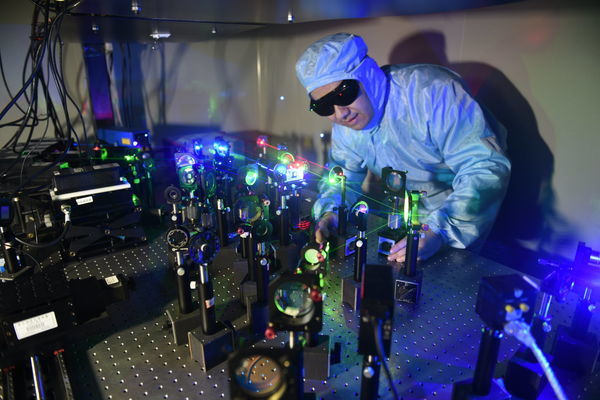
Researchers Develop Nanoparticle Films for High-Density Data Storage
"As we generate more and more data, the need for high-density data storage that remains stable over time is becoming critical. New nanoparticle-based films that are more than 80 times thinner than a human hair may help to fill this need by providing materials that can holographically archive more than 1000 times more data than a DVD in a 10-by-10-centimeter piece of film. The new technology could one day enable tiny wearable devices that capture and store 3-D images of objects or people. “In the future, these new films could be incorporated into a tiny storage chip that records 3-D color information that could later be viewed as a 3-D hologram with realistic detail,” said Shencheng Fu, who led researchers from Northeast Normal University in China who developed the new films. “Because the storage medium is environmentally stable, the device could be used outside or even brought into the harsh radiation conditions of outer space.” In the journal Optical Materials Express, the researchers detail their fabrication of the new films and demonstrate the technology’s ability to be used for an environmentally-stable holographic storage system. The films not only hold large amounts of data, but that data can also be retrieved at speeds up to 1 GB per second, which is about twenty times the reading speed of today’s flash memory." [...]

Scientists create "Swiss army knife" for electron beams
"DESY scientists have created a miniature particle accelerator for electrons that can perform four different functions at the push of a button. The experimental device is driven by a Terahertz radiation source and can accelerate, compress, focus and analyse electron bunches in a beam. Its active structures measure just a few millimetres across. The developers from the Center for Free-Electron Laser Science (CFEL) present their “Segmented Terahertz Electron Accelerator and Manipulator” (STEAM) in the journal Nature Photonics. Terahertz radiation is located between microwaves and the infrared in the electromagnetic spectrum. One of the central features of the device is its perfect timing with the electron beam." [...]
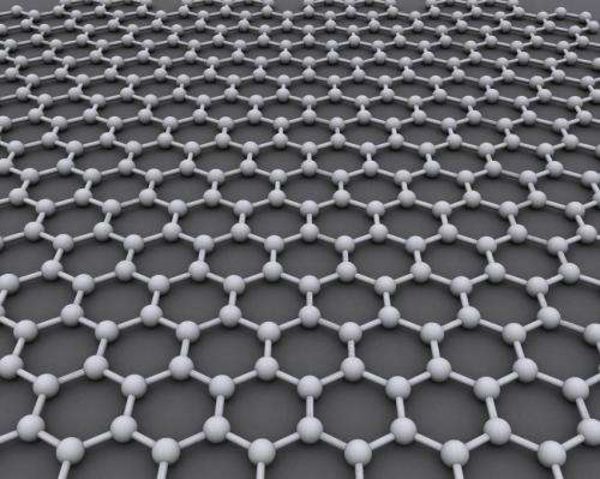
NUS-led research team develops cost effective technique for mass production of high-quality graphene
"Novel method uses 50 times less solvent than conventional methods A research team led by the National University of Singapore (NUS) have developed an economical and industrially viable strategy to produce graphene. The new technique addresses the long-standing challenge of an efficient process for large-scale production of graphene, and paves the way for sustainable synthesis of the material. Graphene is a two-dimensional material with a honeycomb structure of only one atom thick. Dubbed as the material of the future, graphene exhibits unique electronic properties that can potentially be employed for a wide range of applications such as touch screens, conductive inks and fast-charging batteries. The difficulty to produce high-quality graphene affordably on a large scale, however, continues to pose hindrance to its widespread adoption by industries. The conventional method of producing graphene utilises sound energy or shearing forces to exfoliate graphene layers from graphite, and then dispersing the layers in large amounts of organic solvent." [...]

A mechanically robust but readily repairable polymer
"A robust polymer that can be readily repaired unites two properties that seemed mutually exclusive A mechanically robust polymer that can be repaired simply by manually pressing damaged portions together has been developed by researchers at RIKEN and the University of Tokyo1. This finding demonstrates that healing is not limited just to soft materials, and it may lead to display materials that can be fixed rather than replaced. Using durable polymers is important for realizing a sustainable society, but it is typically difficult to repair such mechanically robust polymers when they sustain damage. That is because they are usually made of long, entangled polymer chains, which do not readily diffuse to repair fractures unless the polymer is heated or even melted. Shorter chains that are held together by many hydrogen bonds have been devised, but hydrogen-bonded structures tend to organize into ordered arrays, promoting crystallization and rendering the material brittle. Now, Takuzo Aida from the RIKEN Center for Emergent Matter Science and his PhD student Yu Yanagisawa at the University of Tokyo, together with their co-workers, have hit on a way to circumvent crystallization by using a polymer made of thiourea units (–NH(C)SNH–), which engage in hydrogen bonding, and ether linkers." [...]

Graphene eating silkworms can spin for wearable electronics
"For thousands of years, animals and plants have been used for clothing, from cotton, to wool, to silk from silk worms. In the 20th and 21st centuries, other methods, such as genetic engineering and novel foods, have turned creatures’ bodily processes into factories for drugs or other useful materials. Sheep and goats have produced medicines in their milk, while bacteria have produced alcohol-based biofuels by consuming carbon dioxide. And now, graphene fed worms will produce a conductive silk that allows integrated circuits to be woven into a fabric. The graphene infused silk could be used for wearable devices, such as a maternity dress that provides baby and mother health updates for doctors. The graphene silk’s conductive properties replace the wiring that the wearable sensors would need, while also strengthening the worm-made material." [...]
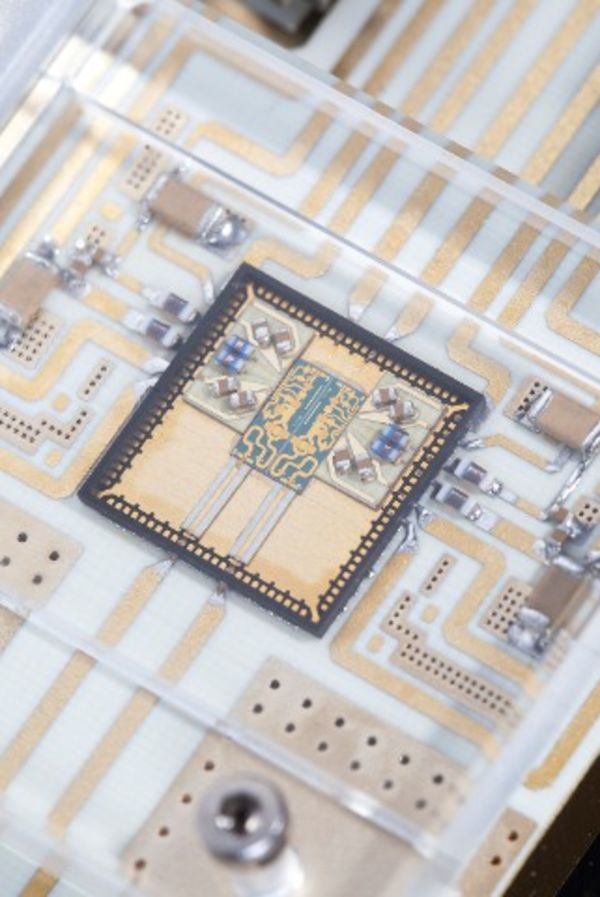
Fraunhofer solves networked sensors' energy problems
"In Fraunhofer‘s lighthouse project, the development of a extremely energy-efficient and modular hardware creates the basis for a comprehensive Internet of Things. The Internet of Things (IoT) is growing steadily. An enormous number of networked nodes collecting, evaluating and converging data in a network is therfore already necessary today. The problem: The energy consumption of the nodes is enormous. According to a study by the International Energy Agency in 2013, the energy requirements of all networked devices worldwide corresponded to the total demand for electrical energy in Germany. Within the next few years, this need will almost double to 1140 terawatts per year, with networked IoT accounting for a significant share of this growth." [...]
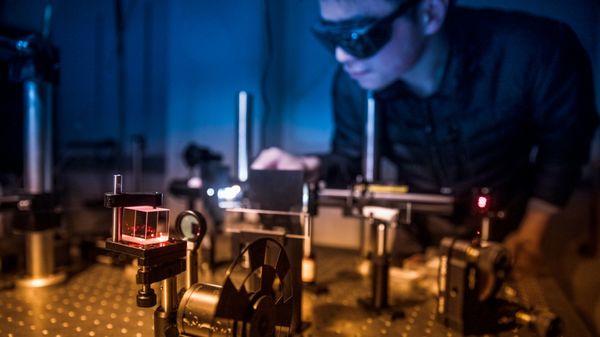
Breakthrough made in atomically thin magnets
"Cornell researchers have become the first to control atomically thin magnets with an electric field, a breakthrough that provides a blueprint for producing exceptionally powerful and efficient data storage in computer chips, among other applications. The research is detailed in the paper, “Electric-field switching of two-dimensional van der Waals magnets,” published March 12 in Nature Materials by Jie Shan, professor of applied and engineering physics; Kin Fai Mak, assistant professor of physics; and postdoctoral scholar Shengwei Jiang. In 1966, Cornell physicist David Mermin and his postdoc Herbert Wagner theorized that 2-D magnets could not exist if the spins of their electrons could point in any direction. It wasn’t until 2017 that some of the first 2-D materials with the proper alignment of spins were discovered, opening the door to an entirely new family of materials known as 2-D van der Waals magnets. Shan and Mak, who specialize in researching atomically thin materials, jumped on the opportunity to research the new magnets and their unique characteristics. “If it’s a bulk material, you can’t easily access the atoms inside,” said Mak." [...]
Documentação
A documentação é parte essencial do processo de aprendizagem e a Internet além de artigos interessantes de explorar também tem alguma documentação em formato PDF interessante de ler. Todos os links aqui apresentados são para conteúdo disponibilizado livremente pelo editor do livro.

CircuitPython Essentials
"You've gone through the Welcome to CircuitPython guide. You've already gotten everything setup, and you've gotten CircuitPython running. Great! Now what? CircuitPython Essentials! There are a number of core modules built into CircuitPython and commonly used libraries available." [...]

newelectronics 27 de Março 2018
"New Electronics is a fortnightly magazine focusing on technological innovation, news and the latest developments in the electronics sector. Downloadable as a digital page turner or pdf file, or offered as a hard copy, the New Electronics magazine is available in a format to suit you. " [...]
Projetos Maker
Diversos Projetos interessantes.

Smart Scooter: Handheld
"Long time ago I've build a smart charger for my scooter HP_Baxxter. Now I had time to also build a handheld for it. Right now only the powerconsumption is shown with the device. I hope that in the future I'm also able to add the finedust and temperature of annother sensor. For the Hardware I've used a ESP8266 together with an display. To power the device a Li-ion 18650 cell is used." [...]
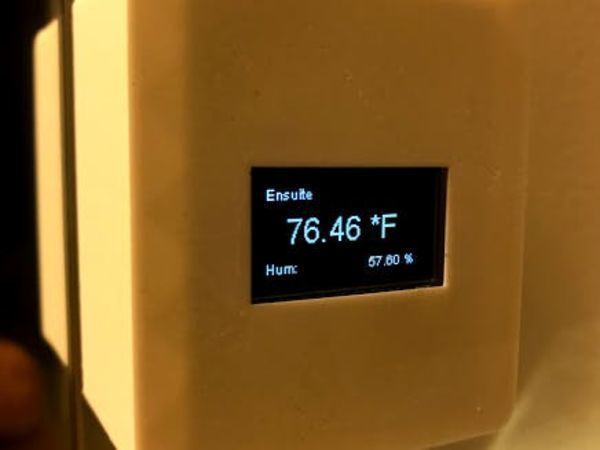
NodeMCU Remote Multisensor With OLED/MQTT
"More than just a pretty (OLED) face - this multisensor (temp, humidity, motion, etc) has MQTT data for your home automation system, as well! This project is my homemade/DIY temperature/humidity multi-sensor, based on the NodeMCU ESP8266, and a DHT22 sensor. It uses a custom-made breakout board for the NodeMCU/DHT I designed in Eagle (available at PCBWay: https://goo.gl/U2fY7y). The breakout board allows me to easily connect things like an OLED screen (for local display), motion sensors or WS2812 RGB LED strings (for LED strip control). The NodeMCU itself runs code I wrote to get the temp/humidty/motion inputs, and publish them via MQTT to my openHAB home automation system. This multi-sensor is really a platform for multiple home automation data gathering tools, and I intend to extend its functionality as time goes on." [...]
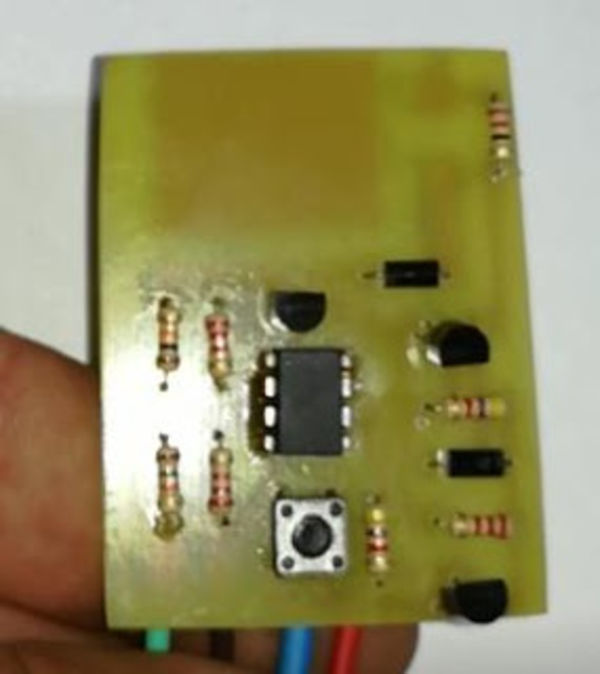
"Daytime Running Light" module (DRL) with ATtiny85
"A reader of my sites and blogs, Mr. Liviu Hinoveanu wanted to replace classical DRL module made with 555 with Attiny85 programmed in Arduino style. He send me the schematic and PCB designed with Livewire and PCB Wisard software: After I undertand what module must work, I write DRL_ATtiny85.ino sketch. Mr. Hinoveanu made module and upload sketch in ATiny85 like in article from Programarea unui microcontroler ATTiny85 cu sketch Arduino. " [...]

Simple Digital Clock Using Arduino
"Make simple digital clock using arduino and simple PCB" [...]

Wi-Fi Browser Controlled Robotic Arm (with Arduino and ESP8266)
"Robotic arms kits are getting cheaper and cheaper. You can find different models online and try different methods to control them. This project is part of a series of tutorials in which I explore different methods for controlling a robotic arm. In my previous experiment, I used a Nintendo Wii Nunchuk to control a 6-joint robotic arm. You can find it here: https://www.instructables.com/id/Nunchuk-Controlled-Robotic-Arm-with-Arduino/ This time I wanted to control it remotelly using an cheap ESP8266 WiFi module. For that, I designed a html interface from which I can send commands to my robot, store them and repeat later." [...]
Build a Cryptocurrency Tracker With ESP8266 and Arduino
"Why? With the latest craze in the world of cryptocurrency and, as coin hodlers ourselves, we wanted to have a tiny desktop display cycling through the current prices of different coins. Although we can certainly find the same information using apps and websites (for free! ), we discovered that having a dedicated device on our desks displaying the data constantly minimized the time we spent on tracking it. Not to mention that building the device is a great excuse to work on a ESP8266-powered, internet-connected, DIY electronics project for any Maker out there! (bro/sis, do you even IoT?)" [...]
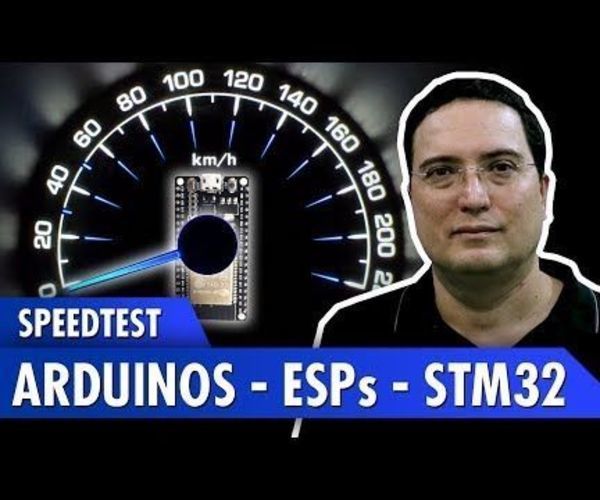
SpeedTest: Arduinos - ESP32 / 8266s - STM32
"Which microcontroller is faster: Arduinos, ESPs, or the STM32? This video examines this question, where I perform a speed test, the SpeedTest, with several devices running the same series of commands. Follow and see the result! Our main goal will be to show how much time each of the chosen microcontrollers spends to execute a series of commands of a simple program. We will perform this test with a program that will execute one million iterations and, from the iteration of 100,000; we will execute commands so that the internal led flashes. I found other speed tests with microcontrollers on the Internet, including one from Chester Lowrey, which produced this table below." [...]
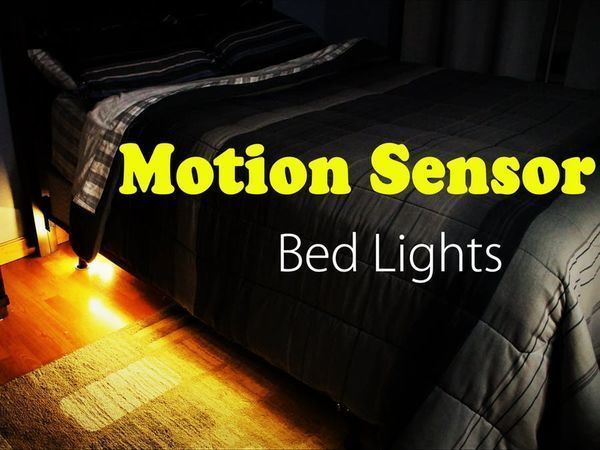
Motion Controlled Bed Lights
"If you have ever woken up in the dark or stepped on something on your bedroom floor because it's too dark, these DIY Bed Lights are for you. Intro: In this Project I show you how to use a $1 Motion Sensor and a stickable LED Strip to make your room smarter and safer for you. When your feet drop down from you bed or you enter your room, lights under your bed will illuminate your floor area. The best part is there's no coding needed to get this to work! " [...]
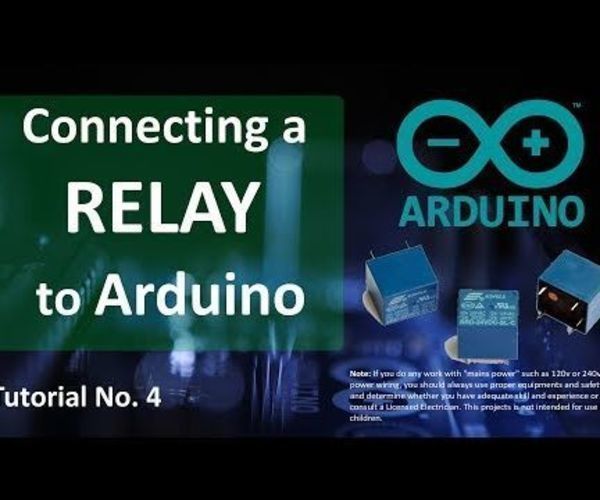
Driving a Relay With an Arduino
"Hello everyone, welcome back to my channel. This is my 4th tutorial on how to drive a RELAY (not a relay module) with an Arduino. There are hundreds of tutorial available on how to use a "relay module" but I could not find a good one that shows how to use a Relay and not a Relay module. So, here we are to discuss how a relay works and how we can hook it up to an Arduino. Note: If you do any work with "mains power" such as 120v or 240v AC power wiring, you should always use proper equipments and safety gears and determine whether you have adequate skill and experience or consult a Licensed Electrician. This projects is not intended for use by children." [...]

3D Printing: Robotic Claw with Arduino
"Did you ever think about designing a manipulator claw using servos? Today, Im going to show you how to control a servo robotic claw using an Arduino Uno. I used two claws to do this. One was made in a 3D printer, and all of its parts were printed on ABS plastic, which I prefer as its more flexible and less brittle. The second claw is acrylic and was cut by a laser. In addition to the claws and the Arduino Uno, we use four micro-servos (3 Tower Pro MG90S and 1 SG90), a 10k potentiometer, as well as a protoboard, wires, and elastics." [...]
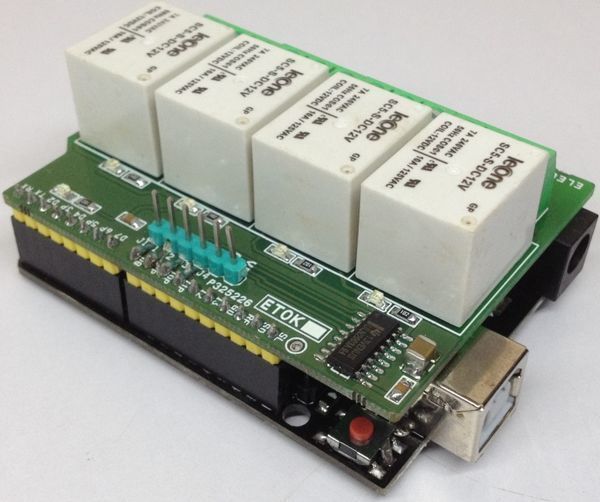
4 Channel Relay Shield for Arduino UNO
"4 Channel Relay Shield for Arduino UNO is a simple and convenient way to interface 4 relays for switching applications in your project. Very compact design that can fit on top of Arduino UNO. Project requires 12V DC supply, all 4 trigger inputs require TTL signal, Relay-1 to Relay-4 inputs connected to D8 To D11 of Arduino digital pins through solder jumpers J1 To J4. All trigger inputs can be connected to other I/O pins of Arduino using female header connectors and you will need to open solder jumpers J1-J4 in this case. D1, D2, D3, D4 LEDs provided to indicate the Relay ON/OFF status. D5 is Power LED." [...]
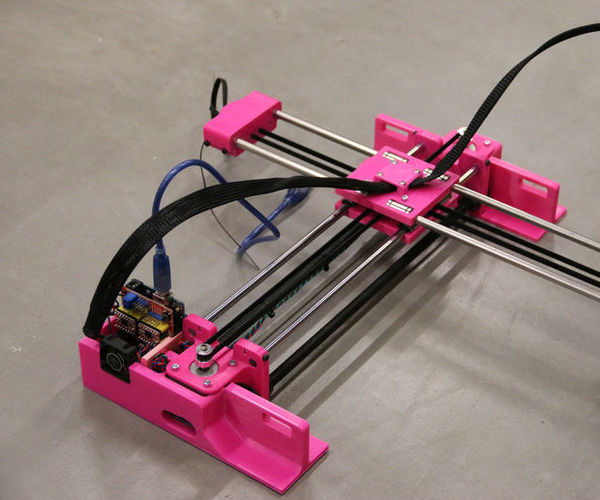
Build Your Own Drawing Machine
"This project was a learning process for learning to build a working machine almost from the scratch. However, since this was my very first assembled machine ever, I had to jump between several instructions and make a lot of extra work to understand every step they described. Therefore, I tried to include everything into these instructions for being helpful and convenient to create this machine even if you are a beginner. This drawing machine is a small three-axis robot that controls a pen over a canvas. For moving the horizontal x- and y-axels, the machine uses a single belt and two stepper motors in a configuration called h-bot, and the third one for moving the vertical z-axel (pen) up and down. For drawing or writing, since the pen orientation is variable, it is possible to use regular ballpoint pens, fountain pens or felt-tip pens." [...]
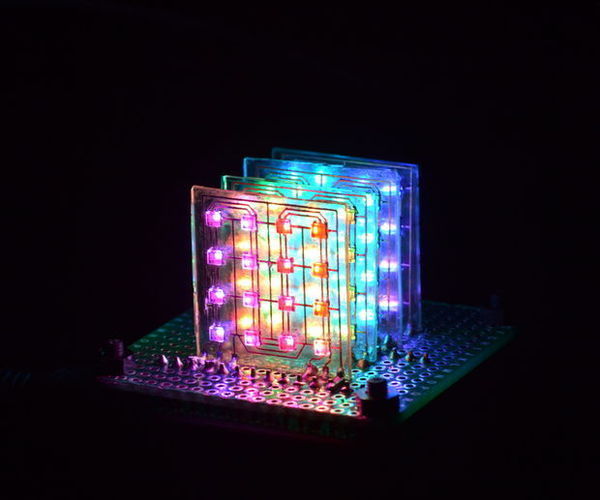
4x4x4 DotStar LED Cube on Glass PCBs
"The inspiration for this project came from other tiny LED cubes like HariFun's and that of nqtronix. Both of these projects use SMD LEDs to build a cube with really small dimensions, however, the individual LEDs are connected by wires. My idea was to instead mount the LEDs on a PCB, as intended for surface mount parts. This would also solve the problem of arranging the LEDs neatly in a matrix with same distances which can be often tricky when connecting them by wires. The obvious problem with PCBs is that they are opaque and therefore the individual layers would be hidden behind each other. Browsing through the web with this in mind, I stumbled upon CNLohr's instructions on how to make clear glass PCBs." [...]
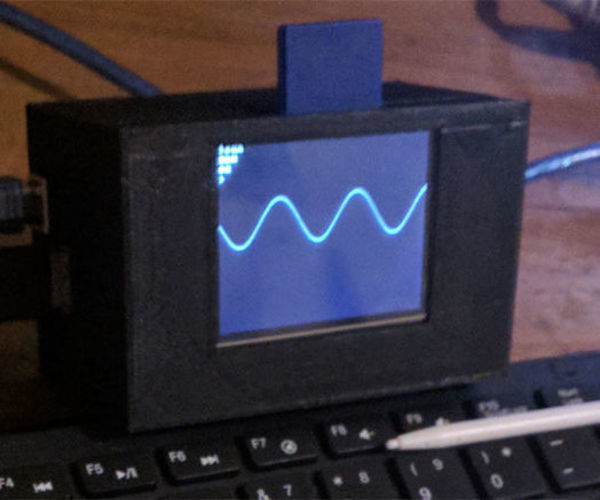
Arduino Mega Based Basic Computer.
"This instructable will document and explain how to build a simple 8 bit basic computer system based upon an Arduino Mega and a simple cheap TFT display. I wanted to create an easy to build and cheap computer using only standard parts. What makes this 8 bit basic computer other than most of the currently available designs? Lets take a look at the specifications: - 8 bit ATmega processor at 16 Mhz; - 8 K internal ram (4 K basic, 1 K heap, 3 K system); - 4K + 32 K Eeprom storage (9 banks); - SD card load and save of program and data; - Efficient use of sram space because program code is tokenized; - Extended basic language with graphics support; - 27 real number variables (doubles) and math functions; - 27 dynamic stings and string functions; - 4 types of dynamic arrays (double,word,byte and bit); - 320 x 240 pixel display with 512 colors; - Fixed (8 x12) font giving 40 characters a line by 20 lines; - USB (PS2) keyboard supported; - 32 free programable I/O pins (back row of the Arduino Mega); - 3D printable case, STL files can be downloaded. This instructable will show you how I build it, because its all standard components, you could design your own version, make the case out of wood, leave the SD out witch will give you 512 bytes of extra sram, add other devices using SPI or I2C, the design is very universal to use and extend. I wrote the basic interpreter myself after a look at Tinybasic (and was very disappointed) and I wrote a complete redesign with my own ideas and optimizations in it." [...]
Neopixel Light Up Sushi Serving Board
"A maker has to make. But one of the things that people will come in for, is everyone has to eat. Christy Canida on Instructables At the intersection of food, technology and the hunger zone, make this light up sushi serving board to better enjoy your food. You have permission to play with your food. " [...]
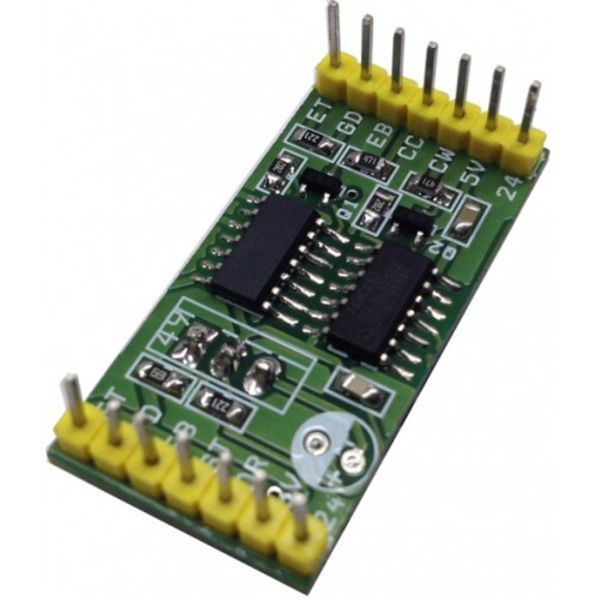
Step/dir signal to CW/CWW signal converter for CNC & motion control systems
"Simple Circuit converts Step/Dir. signal into to double drive CW/CWW Pulse, Mach3 and few Hobby CNC software’s provides Step/Direction pulse output to drive stepper motor drivers. Various AC servo works with double CW/CCW pulse. This circuit is solution to interface such AC CW/CCW pulse based driver with Mach3 or other CNC software’s. Circuit designed around 7408 and 7404 IC, board support 5V or 24V supply. Open Collector output can be interface with 24V system by changing output resistors." [...]

Tetris Time on a P10 RGB Matrix With ESP8266
"I had this P10 RGB LED matrix lying around for a while. I used it with a arduino mega (works good but no easy internet connection) and raspberry pi (flexible, but a big overhead and long startup time). So I was looking for a better solution and I found it when I saw this article on hackaday: https://hackaday.com/2017/11/28/a-minimalist-weath... Dominic Buchstaller built a neat library for the ESP8266 to drive these RGB LEDs matrices. So connecting to the internet for NTP sync is no problem anymore. It also boots up instantly and can be powered off without shutting the system down before. I had the idea to build a NTP synced clock and was looking for a creative way to display the time using available colors." [...]

ESP32 Long Distance - LoRaWan
"In this article, we are going to discuss LoRaWAN, a network that travels with little energy. But for just how far? With the chip I use in the video, the ESP32, the control distance reaches 3.6 kilometers. So today, we talk about the characteristics of the chip and the LoRa network, which was practically made for IoT (Internet of Things). In the assembly, in the example of Heltec, with the ESP32 plus the SX1276 chip, we have Sender sending the data packet to the Receiver. In the green head device, the Receiver, we have the signal that is at -9dB." [...]

Music Reactive Infinite Mirror
"Hi fellow makers! This is a project I've been working on for my Makerspace class at Collgial international Sainte-Anne. I truly hope you will like it! *I'm sorry about the focus being bad. It was almost impossible to obtain a great focus since the LEDs were constantly flashing. * The topic to which this project is related: Since I am a musician myself, music always had been part of my life." [...]

Obstacle Avoiding Robot Using Microcontroller (Arduino)
"In this instructable, I will teach you how to make an obstacle avoiding robot that works with Arduino.You must be familiar with Arduino. Arduino is a controller board which uses the atmega microcontroller. You can use any version of Arduino but I have used the Arduino Uno r3 on my robot. The code is very easy and the circuit has only 4-5 wires. The robot also uses the L293D motor shield which is Arduino compatible, to drive the motors. So, the shield fits straight onto Arduino, making everything easy... Basically, our robot is a car which moves forward and if any obstruction comes in its path, it stops there, moves a bit back, and then its head rotates left and right." [...]
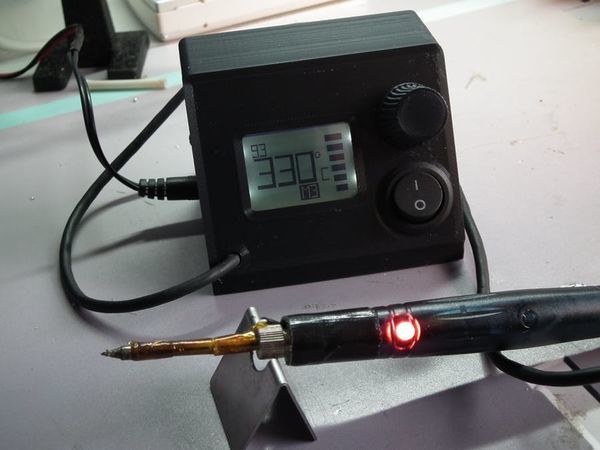
Micro Soldering Station
"The cheapest micro soldering station in the world, using a cheap USB soldering iron. Hi guys. I wanted to create an affordable soldering station that's easy for anyone to build for less than $10. More features to come, but for now it's ready for some action! Enjoy. " [...]
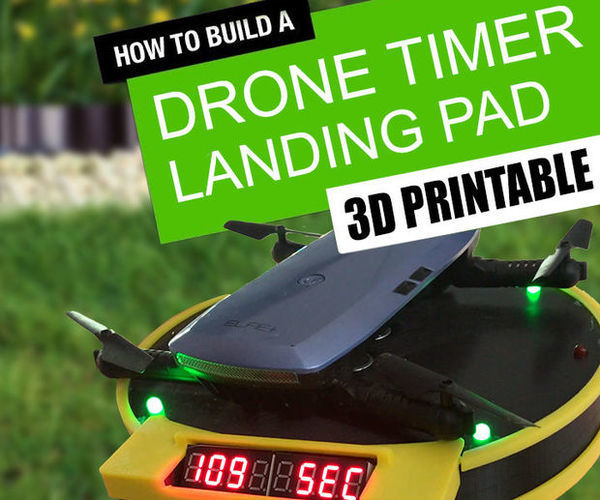
Automatic Drone Lap Timer - 3D Printed, Arduino Powered.
"I've been growing more and more interested in the idea of First Person Video (FPV) drone racing. I've recently acquired a small drone and wanted a way of timing my laps - this is the resulting project. This drone landing pad features an integrated ultrasonic sensor that detects a drones presence. When a drone departs the Arduino starts a timer. When you return your lap time is displayed to you. You can either try to improve your personal best or challenge a friend to do better than you (if you trust them with your drone that is)." [...]
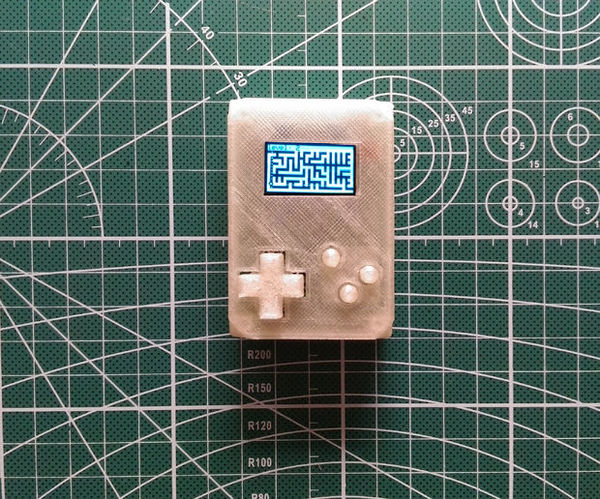
Arduino Pocket Game Console + A-Maze - Maze Game
"The project I want to share with you today is Arduino maze game, which became a pocket console as capable as Arduboy and similar Arduino based consoles. It can be flashed with my (or your) future games thanks to exposed ICSP header. I had an idea few months ago to build a maze game on Arduino, but without hard-coded set of mazes. It should be able to generate a new maze for each level you are playing, so you never see the same maze again :) Code I used as a starting point i took by SANUKI UDON and his project HOW TO MAKE A MAZE GENERATOR USING ATTINY13A" [...]
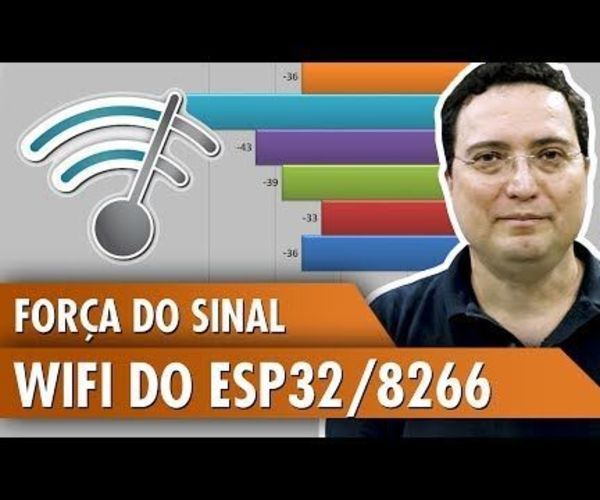
ESP32 / 8266 WiFi Signal Strength
"Do you know about the WiFi signal strength from an ESP? Have you ever thought about getting an ESP01, which has a small antenna, and put it inside a socket? Will it work? To answer these questions, I performed several tests comparing various types of microcontrollers, including ESP32 with ESP8266. We evaluated the performance of these devices at two distances: 1 and 15 meters, both with a wall in between. All this was performed just to satisfy my own curiosity." [...]

LX' Arduino Tetris
"A Tetris game for Arduino Uno and a 32x32 LED matrix panel. A goal I set for myself for easter 2018: get a Tetris game running on a 32x32 LED matrix panel. This one uses Arduino/Genuino Uno as controller, which is rather limited in memory as I experienced. Large parts of the project consisted of finding ways around those limitations. Maybe I'll do a Arduino Mega adaptation for more memory in the near future. The panel's wiring is just like suggested in Adafruit's documentation." [...]
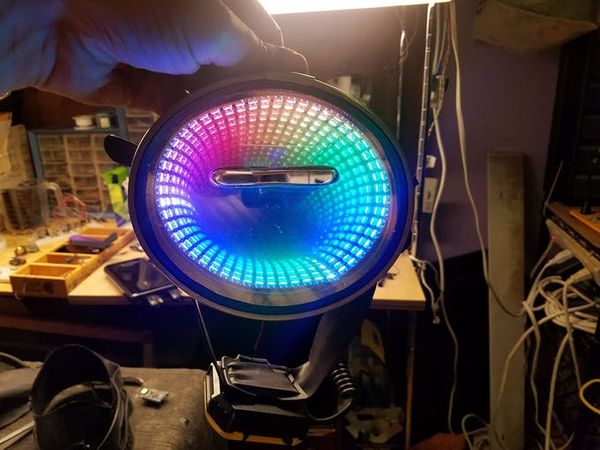
Infinity Mirror Scuba Mask
"Jacques Cousteau style scuba mask turned into an infinity mirror with programmable RGB LEDs controlled by an Arduino. Jacques Cousteau style scuba mask turned into an infinity mirror with programmable RGB LEDs controlled by an Arduino. Unlike other infinity mirror mask/glasses I've seen, this project allows you to see while wearing by adding a wide peephole. Firmware is FastLED library and modified FastLED demo sketch. I added a MPU-9250 accelerometer to make the light show responsive to body movement. An "infinity mirror" is an illusion created when a light source is placed between a full mirror and a partial mirror." [...]

Visual, Audio and Touch Reaction Time Meter
"Reaction time is a measure of time a person takes to identify a stimulus and produce a response. For example an athlete's audio reaction time is time elapsed between firing of gun shot (that starts the race) and him or her starting the race. Reaction time plays an important role in situations of immediate response like 100m Olympic race and applying break in speeding car to name a few. In this miniProject, we create a reaction time meter that lets us measure reaction time for visual, audio and touch stimuli. Let's get started. " [...]

Make Your Own Graphical Weather Station
"Always wanted to have a graphical weather station? And with accurate sensors? Maybe this project is something for you. With this weather station you can see what the weather is "doing". Temperatures for example might rise or fall. From a normal thermometer it is not possible to see the temperature history." [...]
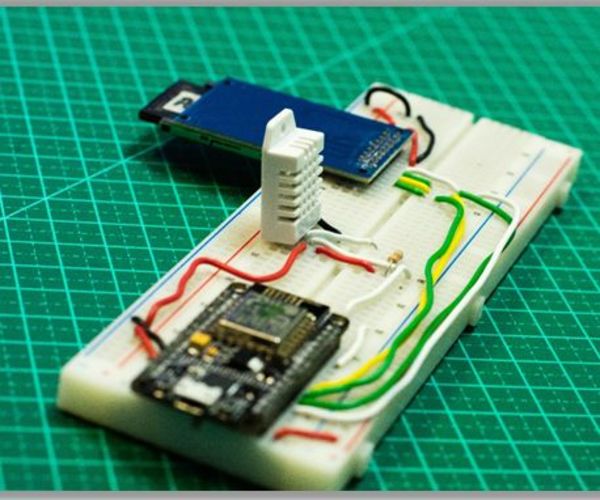
SD Card Module With ESP8266
"In this assembly, we have an SD Card connected to the ESP8266. We put a DHT22, which measures temperature and humidity and sends this information to the SD card. On the circuit, it shows humidity of 43.40 and a temperature of 26.80. Every time that it shows the message "opening the file successfully," its because it ran once in the loop. What occurs in this scenario is as follows: only the values are being written to the log file, and thus, the message "opening the file successfully" is only an advisory, and it is not recorded. " [...]
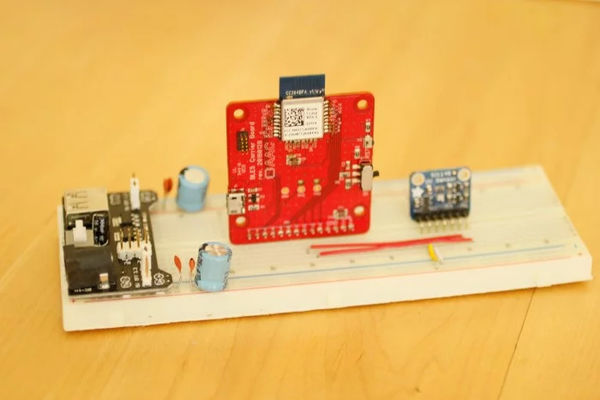
How to Add BLE5 to a Project with a GT-tronics BLE5 Module
"If you're looking experiment with your own BLE5 compatible designs, this project is for you. This article demonstrates a solderless-breadboard compatible carrier-board for a pre-certified BLE4 or BLE5 module made by GT-Tronics. As Bluetooth Low Energy 5.0 (BLE5) continues to enter the market, you will undoubtedly want to start incorporating it into your next design. BLE5.0 remains backward-compatible with previous BLE standards and adds two new PHY layers: long distance (LE 1M coded), which supports link distances of 1.5 km at decreased data rates, and high speed (LE 2M). While very large-scale operations can afford to design custom modules or boards and have them FCC certified, most designers incorporating BLE5 will have to make do with pre-certified modules from secondary manufacturers. This project makes a carrier board for FCC-certified BLE4 or BLE5 modules made by GT-tronics." [...]
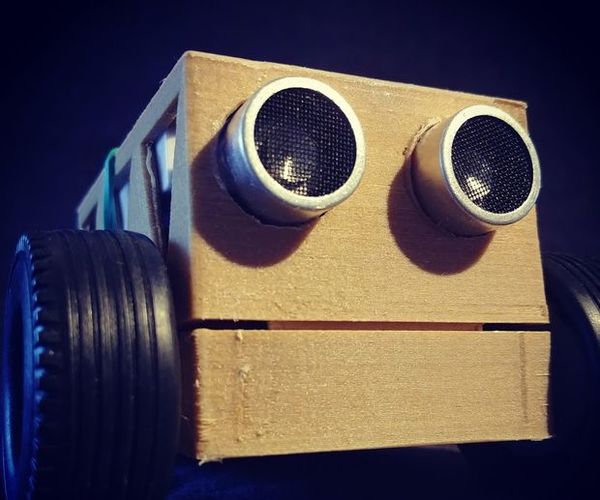
The Smallest and Cutest Arduino Obstacle Avoidance Robot Ever
"Tired of big clumsy robots that take half a shelf in your room? Are you willing to take your robot with you but it just does not fit in your pocket? Here you go! I present to you Minibot, the cutest and tiniest obstacle avoidance robot you could ever (ever ever ever) put together! " [...]

Harmonic Function Generator
"This article describes a simple function generator based on an ATtiny85 which allows you to generate a virtually unlimited number of waveforms using additive harmonic synthesis, by specifying the amplitude of each of the waveform's harmonics: It includes a volume control, audio amplifier, and loudspeaker so you can hear the waveforms. It's not only a useful waveform generator, but also a good introduction to the composition of musical notes. Introduction Unlike most of my other projects on Technoblogy I didn't originally set out to design this. I got the idea after working out a way to add a sine wave to my original Tiny Function Generator project, realising I could take this one step further and use the same technique to allow you to generate arbitrary waveforms by specifying the amplitude of each of their harmonics. Because I wanted to hear the effect on a waveform of modifying individual harmonics, I also added an audio amplifier and volume control to the design so it will drive a loudspeaker. " [...]
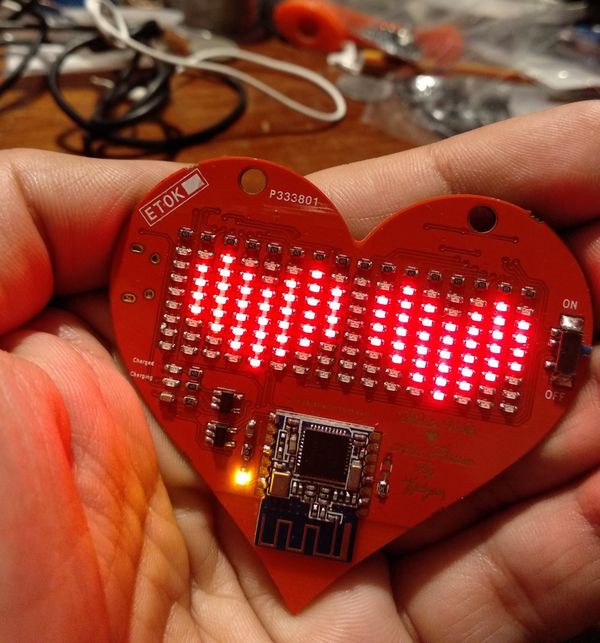
LED BLE Hearty Necklace/Badge
"8*16 LED matrix display with bluetooth low energy to connect to any smart phone DESCRIPTION “There is only one happiness in life, to love and be loved.” – George Sand This LED matrix is a heart shaped circuit which you can make/buy(from me) and gift to your valentine or crush and spread your love. It can be worn as a necklace or as a badge. It has got BLE so you can display any text message on the necklace using a smart phone. In this project I have shared my personal motivation for making this necklace. DETAILS If you have ever fallen in love then you know how it feels. Your days become nights and the nights become your days." [...]
That's all Folks!


